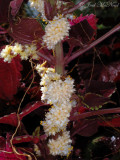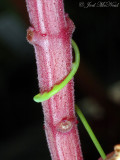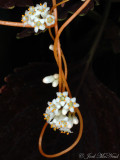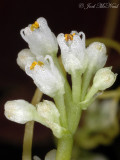Research
My research primarily involves Cuscuta (dodders), a large genus of stem parasitic angiosperm vines in the Morning Glory Family (Convolvulaceae) that lack roots and functional leaves. These parasites produce very little chlorophyll and obtain all their nutrition through rows of organs known as haustoria that form wherever the parasite stem tightly coils around a host plant. The haustoria penetrate the host stem and connect the parasite's vasculature with that of the host, often causing considerable damage to the host in the process. Some Cuscuta species can do serious agricultural damage, while others are very rare and locally distributed. Most Cuscuta species are capable of parasitizing a very broad taxonomic range of hosts, although in nature most species tend to be rather habitat specific and grow on preferred host species.
I use comparative genomics and molecular methods to study the evolution of photosynthetic genes, haustoria, and morphology in a phylogenetic context. More simply, I use DNA and RNA to answer interesting organismal-level questions. Working in my lab can involve anything from visiting field sites in the Blue Ridge Mountains to doing cross-pollinations in the greenhouse to doing DNA and RNA isolations and PCR in the lab to computer analysis of thousands of sequences simultaneously.
I have also published on phylogeny of the family Orobanchaceae, which ranges from fully green, non-parasites to completely non-photosynthetic root parasites. See my photo of Squawroot (Conopholis americana) on the cover of the May 2013 issue of American Journal of Botany.
Current Projects
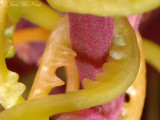 Haustorial genetics of Cuscuta:
Haustorial genetics of Cuscuta:
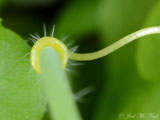 This project examines how genes involved in haustorial development differ between
Cuscuta species, whether unrelated host species induce differential gene expression in haustoria,
and whether defense response to Cuscuta invasion varies between hosts. mRNA from haustorial regions is converted to cDNA,
sequenced, sorted, and compared using a variety of informatics tools.
This project examines how genes involved in haustorial development differ between
Cuscuta species, whether unrelated host species induce differential gene expression in haustoria,
and whether defense response to Cuscuta invasion varies between hosts. mRNA from haustorial regions is converted to cDNA,
sequenced, sorted, and compared using a variety of informatics tools.
Population genetics of Cuscuta rostrata and Cuscuta harperi:
 Cuscuta rostrata (Beaked Dodder) is an Appalachian Mountain endemic that reaches its southernmost
distribution in Georgia. Populations in Georgia are widely spaced, usually contain
very few individuals, and Georgia plants typically look quite unhealthy compared to
conspecifics found at higher elevations in adjacent North Carolina and Tennessee.
Seed set is extremely low in the Georgia populations due to self-incompatability,
a feature not shared with related species in the eastern U.S.
Cuscuta rostrata (Beaked Dodder) is an Appalachian Mountain endemic that reaches its southernmost
distribution in Georgia. Populations in Georgia are widely spaced, usually contain
very few individuals, and Georgia plants typically look quite unhealthy compared to
conspecifics found at higher elevations in adjacent North Carolina and Tennessee.
Seed set is extremely low in the Georgia populations due to self-incompatability,
a feature not shared with related species in the eastern U.S.
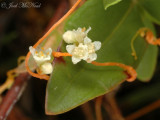 Cuscuta harperi (Harper's Dodder) is a rare, locally distributed species found only on scattered
rock outcrops in Georgia and Alabama. The Georgia populations, like Cuscuta rostrata, are widely disjunct. Unlike C. rostrata, C. harperi likely produces most, if not all of its seeds through selfing.
Cuscuta harperi (Harper's Dodder) is a rare, locally distributed species found only on scattered
rock outcrops in Georgia and Alabama. The Georgia populations, like Cuscuta rostrata, are widely disjunct. Unlike C. rostrata, C. harperi likely produces most, if not all of its seeds through selfing.
Our goal is to develop microsatellite markers for these species to determine how breeding strategy and population size affect genetic diversity and whether any of the Georgia populations of either species are more prone to inbreeding depression than populations from their core range.
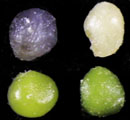 Evolution of Photosynthetic Genes:
Evolution of Photosynthetic Genes:
My Ph.D. research largely focused on the evolution of Cuscuta plastid genomes and the photosynthetic genes retained therein. The results were consistent with the hypothesis that photosynthetic genes, in the Cuscuta species that retain them, are largely conserved for the purpose of lipid biosynthesis in developing ovules. I plan to further examine how gene and biochemical pathways vary between Cuscuta species with vastly different plastid gene content, including those species that lack chlorophyll entirely.






